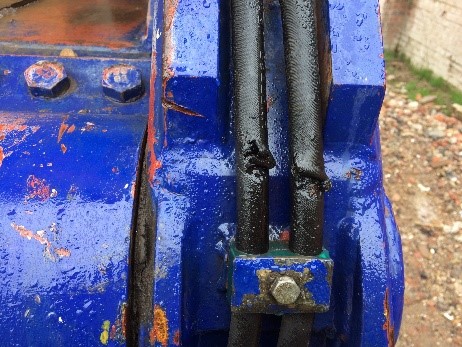The lifespan of a hydraulic hose depends on a variety of factors, such as the type of hose, type of application, operating temperature, pressure and more. Generally, a hydraulic hose will last for several years with proper care but it is important to inspect hoses regularly for signs of wear and tear.
What is the life expectancy of a hydraulic hose?
Hydraulic hoses make operations safe and efficient – but only when installed and maintained correctly.
Regular, thorough inspection of hydraulic hoses can help minimize downtime and ensure the consistency and efficiency of operations.
Maintenance checks will ensure you limit the risk of a burst hose or hose failure and recognise when a hydraulic hose replacement is required.
What are hydraulic hoses used for?
A hydraulic hose is a high-pressure hose used in hydraulic systems to carry fluid to and between components. Hydraulic hoses are used on plant and machinery across a wide range of industries – from agricultural to waste management, as well as in a broad range of manufacturing applications.

They are essential to commonly used vehicles and plant as well as specialist machinery or production lines. They connect valves, tools and actuators for fluids or gases to flow from one component to another.

Hoses can be made up of many combinations. It usually consists of an inner tube made of a synthetic rubber or thermoplastic material, reinforcement layers of steel wire braid or spiral wound textile, and an outer cover of rubber or thermoplastic material. Specialist hoses have certain unique qualities like extra flexibility and abrasive covers or special tubes for use in highly repetitive or aggressive processes.
Depending on their usage and environment a hydraulic hose’s lifespan and maintenance or servicing requirements will vary.
What is the normal lifespan of a hydraulic hose?

With proper assembly, installation, correct usage and ongoing maintenance, a hydraulic hose lifespan can operate for several years.
Of course, correct hydraulic hose assembly and machine servicing are essential to this. And the life expectancy of a hose will always vary depending on each individual hose’s use, composition and environment.
How long a hydraulic hose does last will depend on a number of factors.
In many applications hydraulic hoses withstand high pressures, high temperatures, harsh substances and challenging operating environments. Over time, these conditions can damage and degrade a hose,
risking leakage or failure.
For example, even a high temperature hose will fail if it is subjected to temperatures higher than its make up allows for. And aged hoses, used for longer than their shelf life, will become brittle, risking cracking and causing a hydraulic hose leakage.
What maintenance checks can I make?
To prevent hydraulic hose breakdown and reduce the risk of regular hydraulic hose replacement, a number of maintenance processes should be followed.
Regular monitoring of hoses, looking out for any abrasions externally or obstacles in their immediate environment, should be completed.
Similarly, the fluids or gases flowing through the hoses should be monitored to ensure they cannot degrade or erode the inside of the hose. The end fittings or couplings a hose is connected to should also be monitored, to ensure their threads remain robust and a leakage or burst isn’t likely.
A hydraulic hose’s usage should also be monitored, ensuring it is not being subjected to pressures or temperatures either too high or too low for its intended use, or fluids too harsh for its construction.
Developing a comprehensive maintenance and servicing plan will allow for these checks to be completed regularly. This should be suitable to the hose’s usage and location, and also relative to the risk or costs associated with a potential hydraulic hose breakdown.
When does a hose need replacing?
Maintenance checks will flag when a hydraulic hose replacement is needed, either imminently or immediately.
Signs that a hydraulic hose replacement is necessary will include twists, kinks, tears or rips in the hose, or visible wires, all indicating structural weakness or increased stress. If oil or fluid is visible on the outside of the hose, this indicates hydraulic hose breakdown or failure, and the hose should be replaced immediately.

Cracked or corroded fittings indicate the risk of a leak or burst, creating a potentially hazardous situation.
As well as maintenance checks carried out by the team responsible for the hoses, a performance and condition check by a hydraulics specialist is recommended. This will allow for a comprehensive review of the hoses condition and performance.
Specialist checks can also assess the performance and quality of the fluids flowing through the hose, through fluid analysis. If these become contaminated or degraded, they can rapidly shorten the hydraulic hoses’ lifespan as well as impact the efficiency or accuracy of processes.
If and when critical errors are identified, hydraulic hose replacement is essential. Standard repairs are not advisable with hydraulic hoses due to their specialist nature. Instead, new, safe components should be installed.
Can I replace a hydraulic hose?

While basic maintenance and checks can be completed by your own team, full inspection and replacement of hydraulic hoses should be completed by a trained hydraulics expert.
With specialist understanding, skills and equipment at our disposal, our team are able to complete checks greater than simple visual checks
At Hydroscand we are experts in hydraulic hoses, able to offer advice and guidance on how to maximise the efficiency and lifespan of a hose. For more information, contact us at: info@hydroscand.co.uk or: 0800 0116 999, or visit: www.hydroscand.co.uk


